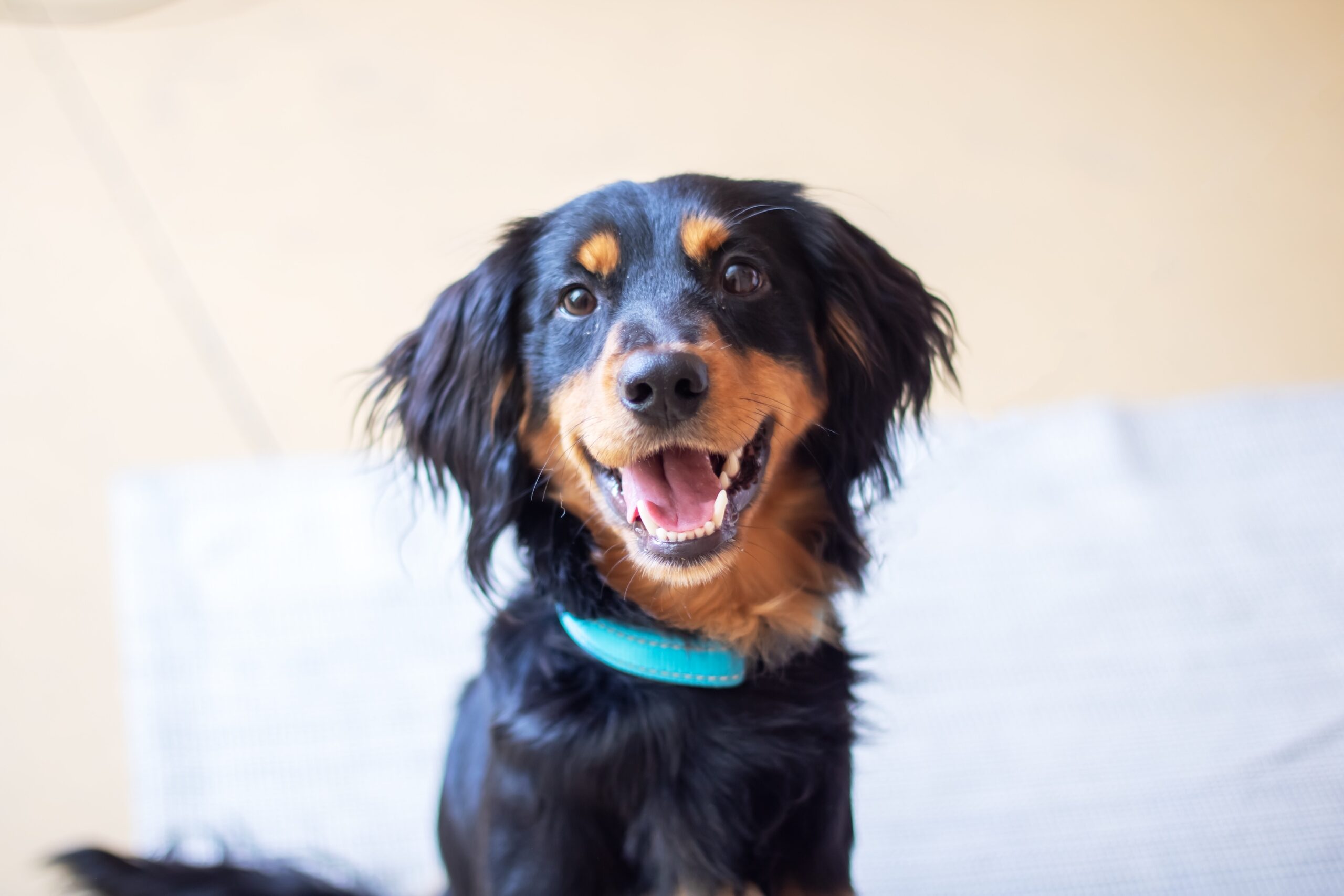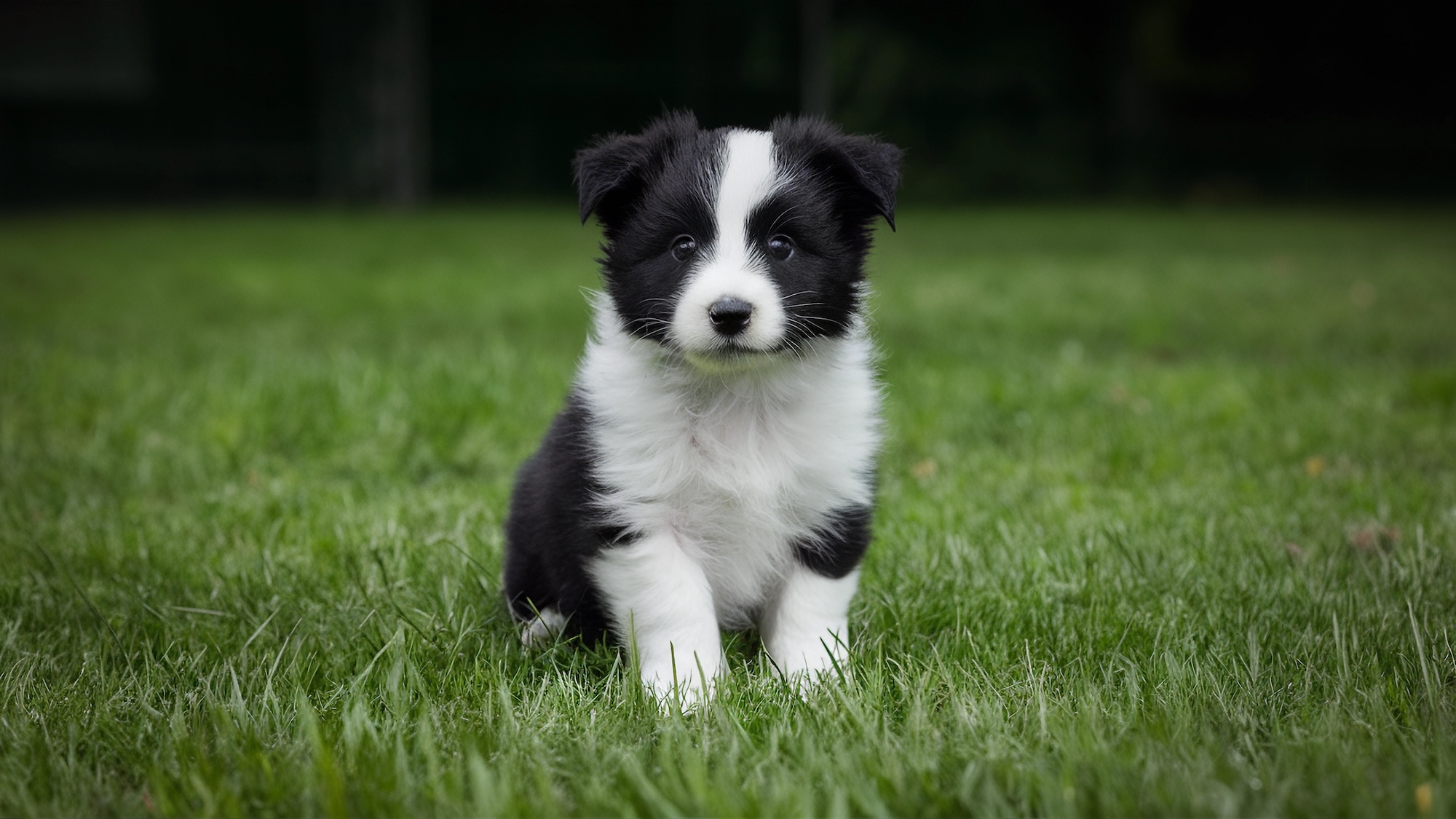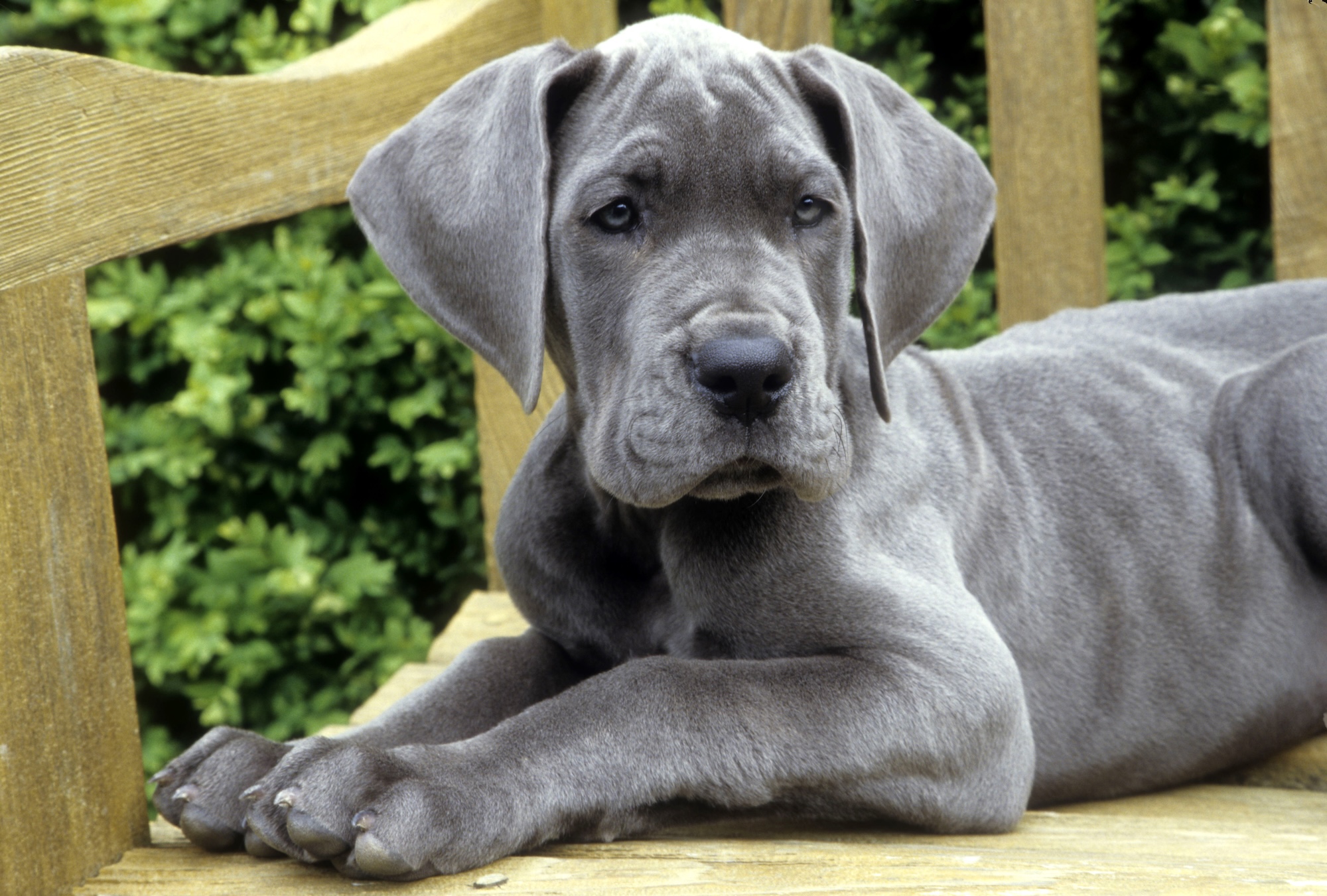This article was updated in April of 2025.
Key points:
- The size, color, shape, and consistency of a dog’s poop can tell you a lot about their health.
- Take note of what’s normal for your dog so that you’ll be aware of any changes.
- Going anywhere from once to three times a day can be normal for an adult dog, but an unexplained change in frequency is a reason to call the vet.
- If you have any questions or concerns about your own dog’s poop, the best thing to do is call your vet.
You might not think much about your dog’s poop beyond the need to pick it up and throw it away—but it can actually tell you a lot about their health. “[That’s] why veterinarians spend so much time talking about dog poop,” says Brian J. Bourquin, DVM, owner of Boston Veterinary Clinic. The clues reside in the poop’s size, color, shape, and consistency. Here’s what to look for.
Know what’s normal for your dog
First, it helps to have an idea of what’s “normal.” As a rule, if your dog’s stools are firm, log-shaped, easy to scoop, and a chocolate-brown color, those are all good signs and point to a healthy digestive tract. However, “normal” can vary from dog to dog. That’s why veterinarians advise owners to pay attention to their dogs’ typical potty habits and output. If you know your dog’s baseline, you’ll have an easier time knowing when something may be amiss.
Volume
The amount of poop a dog produces can vary depending on their overall health, how much they eat, what’s in their food, and that food’s digestibility (how much of its nutrition the dog’s body absorbs). Dogs who are fed highly digestible food will likely produce smaller poops, because their bodies will absorb more of the food’s nutrition—meaning that less of it will come out as waste. Third-party studies have clinically proven that The Farmer’s Dog food is highly digestible.
In a 2021 study, researchers compared dogs eating kibble, non-human-grade fresh food, and human-grade fresh food. They found that dogs eating kibble produced significantly more poop—up to 1.7 times more than those on non-human-grade fresh food, and up to 2.9 times more than those on human-grade fresh food. The Farmer’s dog is a human-grade fresh food.
Frequency
This is a case where it helps to know what’s normal for your pet. On average, an adult dog will poop 1–3 times a day—and puppies will do so more frequently. As long as the color and consistency of their poop appear healthy, it’s all considered completely normal. However, a sudden increase or decrease in frequency could be a sign of a digestive issue. If your once-daily canine friend is suddenly begging to be let outside multiple times a day, there may be something amiss. And if your dog doesn’t poop for two days, is straining to defecate, vomits, loses their appetite, or becomes lethargic, call your vet.
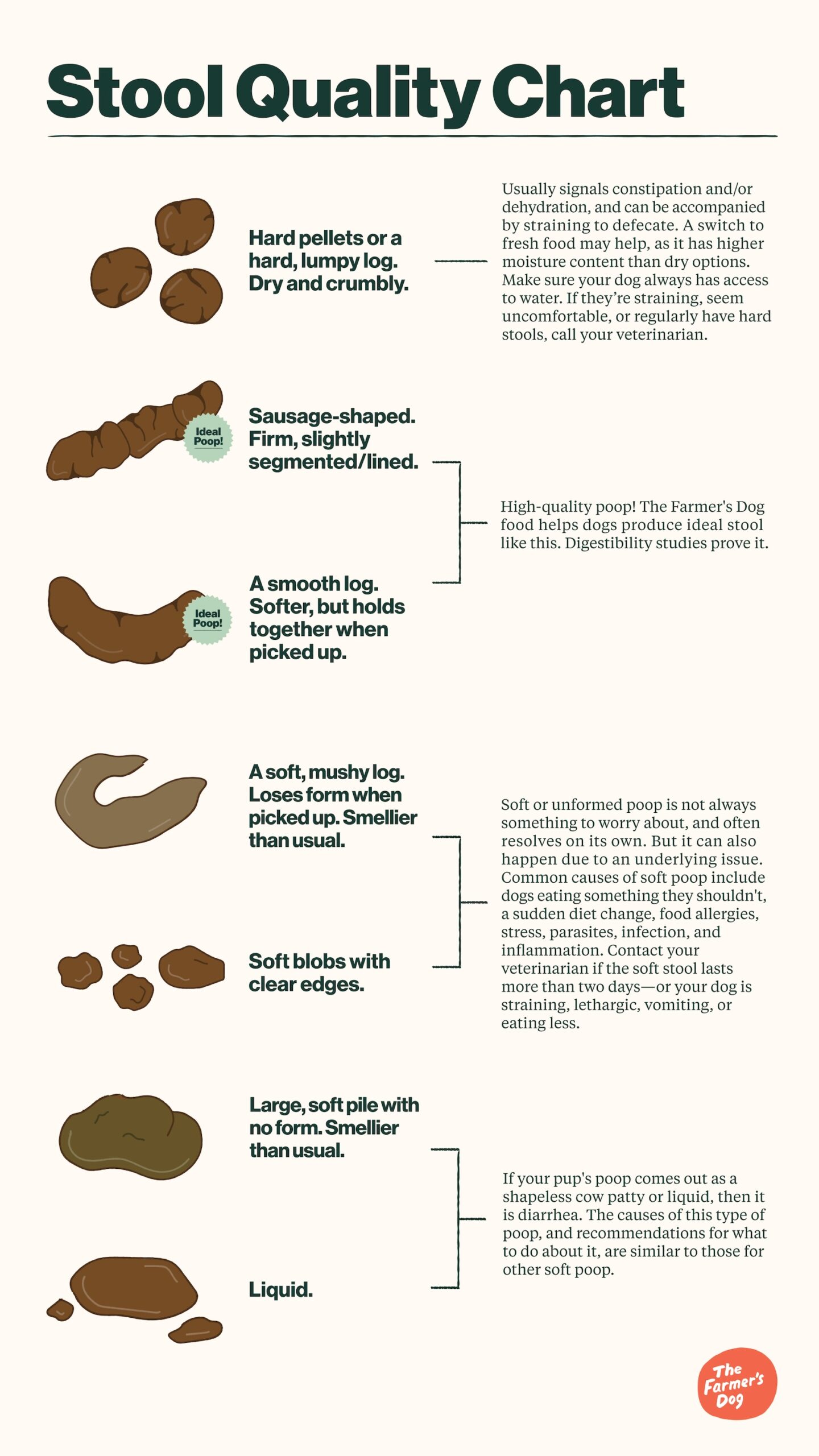
Consistency and shape
For the most part, your dog’s poop should be well-formed, log-shaped, and easy to pick up without leaving any on the ground. Slightly softer-than-usual stool is not always a concern, and typically resolves in a day or two—but if it continues for more than a couple of days or recurs frequently, your dog is straining to poop, they’re lethargic, or they’re eating less than usual, contact your veterinarian.
If your dog’s poop is round, pellet-shaped, or hard, it could be a sign of dehydration. If you’re noticing poop like this frequently, it’s a good idea to check in with your vet.
Hard stools can also lead to straining when your dog tries to poop. Common reasons for straining include constipation, irritation, or inflammation in the lower digestive tract; pain; or a blockage in the colon or rectum. If you notice that your dog is straining, give your vet a call.
Color
A normal stool for a dog should be medium-to-dark brown in color. According to Dawn M. Spangler, DVM, associate professor of shelter medicine at Lincoln Memorial University College of Veterinary Medicine in Tennessee, “the color of the stool should be fairly consistent from day to day, providing the dog eats a regular diet.”
Other colors in your dog’s poop aren’t always a cause for concern, particularly if they’re reflecting something they may have eaten. If your dog snatched a few carrots from your dinner plate, you shouldn’t be alarmed to see some orange in their stool the next day. But pay attention if you’re seeing unusual colors that you can’t explain, or that last for more than one poop.
Black poop
Black, tarry stools are often caused by something serious: Bleeding in the stomach or small intestine. “The stool turns black because blood has been digested, causing it to change color,” Dr. Spangler says. Known as melena, black stool can result from a range of ailments including parasites, blood swallowed from the mouth or nose, blood-clotting issues, or tumors. As such, if you see it, you should call your vet right away.
Red poop
Unless your dog ate something red, red stools most likely indicate fresh blood coming from the colon, rectum, or anus. Red stools can be a sign of parasites; dietary allergies; inflammation or infection of the colon, rectum, or anal sacs; a tumor; an intestinal blockage; or a bleeding disorder—all of which require veterinary intervention. If you see a small streak of blood that resolves after one or two more poops, you may not need to worry. But if it persists longer than that, your dog is straining to defecate, they’re lethargic, or they have a reduced appetite, consult your veterinarian.
Grey and white poop
Grey or light-tan/white stools can indicate liver, gallbladder, or pancreatic diseases—all of which require veterinary attention. A dog’s stool can also look white due to a diet that’s high in calcium—for example, if it contains a lot of bone or eggshells. The appearance of white flecks in a dog’s stool can be a sign of worms, which can be contagious and require veterinary attention (note that rice grains may also be confused for worms).
Green poop
Your dog’s poop may look green if they ate green treats or foods, or if they ingested grass. Grass itself is not dangerous to dogs, but it can be hazardous if it’s been treated with herbicides or pesticides. Very large amounts of grass can also cause a gastrointestinal blockage. Other causes of green poop include gallbladder issues and infections. If your dog’s poop is frequently green, or they seem sick, talk to your vet.
Orange poop
Orange foods or treats can make your dog’s poop look orange, but this color can also indicate liver or gallbladder issues. If your dog’s poop is only orange once, and they otherwise seem normal, you can just watch them closely. But if it persists or recurs frequently—or if your dog seems sick—get in touch with your vet.
Yellow poop
A dog’s poop might look yellow because of a change to their diet; a pancreas or liver problem; or an infection of the gastrointestinal tract. If you see yellow poop once, but your dog isn’t showing any signs of illness, monitor them. But, again—if this lasts for more than a day or your dog otherwise seems sick, it’s time to call the vet.
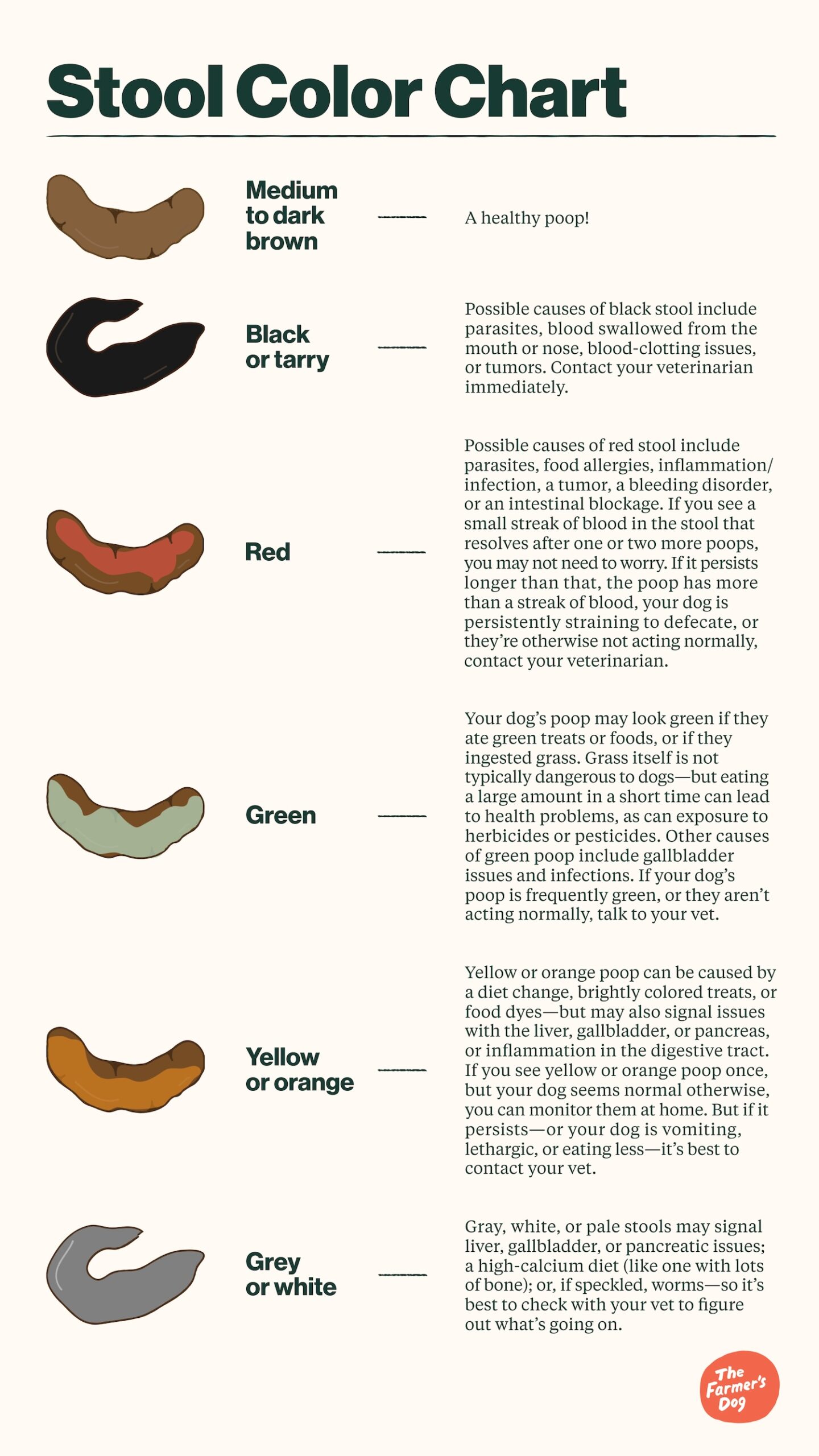
Foreign material
If you see foreign material—like a piece of a toy, a chicken bone, or anything else that shouldn’t go in their body—in your dog’s poop, call your vet right away for guidance. Unfortunately, if all pieces of the foreign object don’t successfully pass through their digestive system, there’s a risk of intestinal obstruction—a painful and potentially life-threatening blockage of the gastrointestinal tract. If you notice vomiting, loss of appetite, or lethargy, bring your dog to the vet immediately.
Diarrhea
Many pet owners are unsure about when their dog’s loose, watery stool is something to be worried about, and when it’s a passing anomaly. First, you can start determining potential causes for the diarrhea—did they sneak some “non-approved” food earlier that day, or did their diet recently change?
If your dog has one loose or watery poop, it’s usually nothing to worry about. It could be caused by stress, or eating something they shouldn’t—what vets sometimes call “garbage gut”—and can resolve on its own in a day or two. Other possible causes of diarrhea include food allergies, parasites, infections, inflammation, a blockage in the intestines, toxins, tumors, and Addison’s disease or other issues with hormone-producing glands. If the diarrhea persists for more than two days—or your dog is straining, becomes lethargic, has a reduced appetite, or is vomiting—you should contact your veterinarian.
If your dog’s diarrhea is an ongoing issue, your veterinarian may recommend a rectal exam, a fecal test, bloodwork, abdominal X-rays, and/or an ultrasound. The vet may also recommend other diagnostics depending on these results and your dog’s condition.
Pet owners should pay attention to anything out of the ordinary between rounds of poop—as it’s often the other signs accompanying diarrhea that can signal trouble. According to Dr. Spangler, a vet visit is warranted if your dog refuses to eat and/or drink water for more than 24 hours, appears lethargic, or is experiencing problems like persistent vomiting or ongoing diarrhea. “[Dogs] can quickly become dehydrated, so it’s better to see a veterinarian sooner rather than later to get them the care and treatment they need,” she says.
Mucus
Dog stool often contains some mucus, and that’s typically nothing to worry about. Mucus is a slime-like substance made by the intestines to keep the lining of the colon lubricated and moist. In the right amount, it’s perfectly healthy and helps prevent constipation. But excessive mucus in the stool may indicate a medical condition that requires veterinary care. Causes of excessive mucus in the stool include a sudden switch in diet, not digesting food well, stress, parasites, infection, inflammation, and ingestion of foreign material. Contact your veterinarian if you see more mucus than usual for more than two days, excess mucus keeps coming back, or your dog is showing signs like diarrhea, vomiting, lethargy, or loss of appetite.
Poops during food transition
Any change in your dog’s diet can affect their poop. While some dogs handle food transitions without any issues, others might have temporary changes—like softer stools or mild diarrhea.
This is pretty normal, and often clears up in a few days—especially if you transition your dog’s food gradually. If your dog’s stool seems too loose, it can help to slow down the transition a bit. As long as your dog is behaving normally—eating, drinking, and playing—these “transition poops” are usually nothing to worry about.



